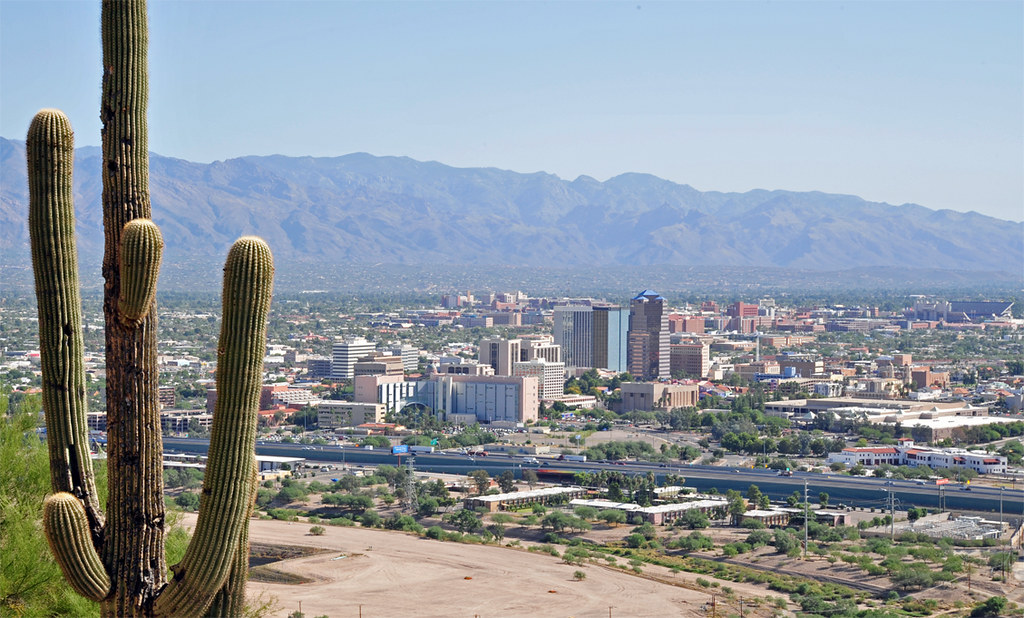Get more Southwest News & Travel Tips Here
Tucson Arizona: A Comprehensive Travel Guide
Where is Tucson Arizona located?
Tucson is a vibrant city located in southern Arizona, within Pima County. Positioned in the Sonoran Desert, this city is surrounded by stunning mountain ranges, including the Santa Catalina Mountains to the north and the Tucson Mountains to the west. Tucson, Arizona is not only a city but also a cultural hub in the region, offering a unique blend of Native American, Mexican, and Western influences.
Get more Southwest News here!
Best Time to Visit Tucson Arizona
The best time to visit Tucson, Arizona is during the fall and spring months when the weather is mild and pleasant. Average temperatures in the fall (September to November) range from 70°F to 90°F, making it ideal for outdoor activities. Conversely, the summer months can get extremely hot with temperatures often exceeding 100°F, while winter nights can be chilly, leading many to wonder, does it get cold in Tucson Arizona? Snow is rare, but does it snow in Tucson Arizona? occasionally, usually only at higher elevations. Be sure to check local festivals and events, as Tucson hosts numerous cultural celebrations during these seasons.
How to get to Tucson Arizona?
Traveling to Tucson, Arizona is convenient due to its proximity to major transportation hubs. The city is served by the Tucson International Airport (TUS), which offers both domestic and limited international flights. For travelers seeking larger international connections, Phoenix Sky Harbor International Airport (PHX) is about 116 miles away, providing more options. Additionally, charter flights are available for those preferring a more private travel experience.
What to do when you arrive:
Upon arrival in Tucson, your first stop should be the Visitor Center located in downtown Tucson. Here, you can gather essential information about Tucson, Arizona, including maps, brochures, and recommendations for local attractions. There are various hotels and accommodations to choose from, ranging from luxury resorts to budget-friendly motels.
Getting Around Locally
Getting around Tucson, Arizona is easy with several options available. The city has a public transportation system, Sun Tran, providing bus services across key areas. For more flexibility, consider renting a car, especially if you plan to explore the outskirts and nearby natural attractions. Biking is also a popular option, with numerous bike trails available throughout the city.
Top Things to Do and See in Tucson Arizona:
-
Arizona-Sonora Desert Museum
This unique museum combines a zoo, botanical garden, and natural history museum, showcasing the diverse flora and fauna of the Sonoran Desert. Visitors can experience the desert ecosystem up close.
-
Sabino Canyon
Located in the Coronado National Forest, Sabino Canyon offers stunning hiking trails, scenic views, and numerous picnic spots. It’s an excellent destination for outdoor enthusiasts.
-
Mission San Xavier del Bac
This historic Spanish mission, founded in the late 1700s, is known for its stunning architecture and rich cultural history. It’s a must-see for anyone interested in the history of Tucson, Arizona.
-
Old Tucson Studios
A film studio and theme park, Old Tucson showcases the Wild West era with live shows and historic film sets. It’s a fun attraction for families and history buffs alike.
-
Tucson Botanical Gardens
These beautiful gardens feature a wide variety of plant species, including local cacti, and offer a serene escape in the heart of the city. It’s a great place to relax and enjoy nature.
Suggested Itineraries
For a weekend visit, consider spending your first day exploring the Arizona-Sonora Desert Museum and Sabino Canyon. On your second day, delve into Tucson’s rich history at Mission San Xavier del Bac and spend the afternoon at Old Tucson Studios. Don’t forget to explore local restaurants in Tucson, Arizona, for an authentic culinary experience.
Permits & Fees
Most attractions in Tucson, Arizona, charge admission fees. For example, the Arizona-Sonora Desert Museum has an entry fee, while some state parks may require a parking permit. Always check online for the latest information about permits and fees before your visit.
Nearby Day Trips & Detours
Tucson serves as an excellent base for day trips. Consider visiting the charming town of Bisbee, known for its historic mining past, or head to Mount Lemmon for stunning views and outdoor activities. You can also explore the nearby Saguaro National Park to see the iconic cacti that define the region.
Local Culture & History
Tucson, Arizona, is rich in cultural history, with influences from Native American tribes, Spanish settlers, and Mexican heritage. The history of Tucson Arizona dates back over 12,000 years, making it one of the oldest continuously inhabited areas in North America. The city is named after the O’odham word “Cuk Son,” which means “at the base of the black mountain.” As you explore Tucson, you’ll find vibrant neighborhoods, art districts, and a culinary scene that showcases local flavors.
With a growing population, currently around 550,000 residents, Tucson, Arizona is a dynamic city that continues to evolve. As you plan your visit, remember that Tucson is in the Mountain Standard Time zone.
Whether you’re interested in outdoor adventures, historical explorations, or simply soaking in the local culture, Tucson, Arizona offers a diverse range of attractions that cater to all interests.
Where to Stay in Tucson Arizona
Tucson offers a wide range of accommodation options suitable for all types of travelers. Whether you’re looking for luxury, budget-friendly options, or unique lodging experiences, you’ll find something that fits your needs.
- Hotels:
- JW Marriott Tucson Starr Pass Resort & Spa – A luxurious resort with stunning views, a spa, and several dining options.
- Hotel Congress – A historic hotel located in downtown Tucson, known for its lively atmosphere and live music events.
- La Quinta Inn & Suites by Wyndham Tucson Airport – A budget-friendly option with comfortable rooms and complimentary breakfast.
- Motels:
- Rodeway Inn Tucson – An affordable motel providing basic amenities and easy access to local attractions.
- Super 8 by Wyndham Tucson – A reliable choice for travelers seeking simple accommodations without breaking the bank.
- Campgrounds:
- Gilbert Ray Campground – Located within Saguaro National Park, this campground offers stunning views of the surrounding desert.
- Colossal Cave Mountain Park – This site features campgrounds and offers guided cave tours, making it a great spot for adventure seekers.
- Yurts & Glamping:
- Sky Island Retreat – Offers unique yurts and glamping tents set in the beautiful landscape of the Santa Catalina Mountains.
- AirBNB & VRBO:
- For a more personalized stay, consider checking out local listings on AirBNB or VRBO. You can find charming casitas, homes with desert views, and more.
- KOA:
- Tucson/Lazydays KOA – A family-friendly campground offering cabins, RV sites, and a host of activities for all ages.
Dining Options
Tucson’s culinary scene is as diverse as its culture. From quick bites to upscale dining, there is something here for every palate.
- Grab & Go:
- Prep & Pastry – A local favorite for breakfast and brunch, offering delicious pastries and coffee.
- Seis Kitchen – Specializes in Mexican street food with a modern twist, perfect for a quick meal on the go.
- Family Friendly:
- Old Pueblo Grill – Known for its hearty portions and family-friendly atmosphere, serving up delicious Sonoran-style burritos.
- Famous Sam’s – A casual sports bar that offers a diverse menu, including burgers, wings, and salads.
- Upscale Dining:
- Fleming’s Prime Steakhouse & Wine Bar – A top-notch steakhouse with an extensive wine selection.
- Jax Kitchen – Offers an upscale dining experience with a menu that highlights local ingredients and flavors.
- In-Park Dining:
- Saguaro National Park Visitor Center Café – A great spot to grab a quick bite after exploring the trails, featuring snacks and beverages.
Travel Tips & Safety
Traveling in Tucson requires some special considerations to ensure a safe and enjoyable experience. Here are some essential tips:
- Stay Hydrated: The desert climate can be very dry, so always carry water with you, especially when hiking.
- Sun Protection: Apply sunscreen regularly, wear a wide-brimmed hat, and use UV-protective sunglasses.
- Wildlife Caution: Be aware of local wildlife, including snakes and scorpions, especially when hiking or camping.
- Emergency Services: Keep local emergency numbers handy. For parks, check the National Park Service’s website for alerts and updates.
- Road Conditions: For current road conditions in Arizona, visit the Arizona Department of Transportation website.
Packing List & What to Bring
When visiting Tucson, it’s important to pack appropriately for the weather and activities. Here’s a suggested packing list:
- Comfortable hiking shoes or boots
- Lightweight, breathable clothing
- Swimsuit (if your accommodations have a pool)
- Reusable water bottle
- Sunscreen, hat, and sunglasses
- Camera or smartphone for photos
- Binoculars for wildlife viewing
Wildlife & Nature Highlights
Tucson is surrounded by stunning natural landscapes that are home to diverse wildlife. Here are some highlights:
- Saguaro Cacti: Iconic to the region, these towering cacti can be seen throughout the national parks.
- Bird Watching: Tucson is a prime location for bird enthusiasts, with opportunities to see species like the Gambel’s quail and various hummingbirds.
- Desert Wildlife: Keep an eye out for javelinas, coyotes, and other desert animals during your explorations.
Accessibility Information
Tucson strives to be accessible to all visitors. Many attractions and hotels offer accessible facilities, including:
- Accessible parking spaces
- Wheelchair rentals at some national parks
- Accessible hiking trails in parks like Saguaro National Park
FAQs
Here are some frequently asked questions about traveling to Tucson:
- Is Tucson Arizona safe for tourists? – Yes, Tucson is generally considered safe for tourists, but like any city, it’s important to stay aware of your surroundings.
- What is the local currency? – The currency in Tucson, as in the rest of the United States, is the US dollar.
Conclusion & Additional Resources
Tucson, Arizona, is a destination rich in culture, outdoor activities, and culinary delights. Whether you’re hiking in the stunning desert landscapes or exploring the city’s vibrant neighborhoods, Tucson offers something for everyone. For more travel tips and in-depth information, be sure to check out Visit Southwest.
Follow us on Facebook for updates and more travel inspiration: National Park Adventurers.

